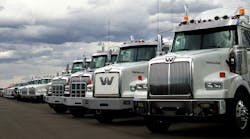In the last two postings there have been many good comments as well as peer dialog in reference to fuel gelling, additives and kerosene along with USLD fuel and winter related service interruptions.
One comment pointed out that no one has talked about fuel heaters. That was because my original intention was to make people aware that fuel gelling not normally the problem, and that they need to look deeper for the root cause of cold weather fuel issues.
Yes, FUEL HEATERS play an important role. Most trucks are equipped with them, and those that are not are usually stock trucks or trucks that are operating only in warmer climates wear they are considered an unnecessary expense. Most fuel heaters today are part of additional fuel filtration systems, which in my opinion are a must and not an option in specing a vehicle. Available with electric or coolant warming, I usually choose coolant, unless as in smaller vehicles there is no other option.
Early in my career I was visited by a fleet guy turned supplier, and he showed up peddling an aluminum canister he called a fuel heater. It was simple design, fuel in the top, fuel out the top, hot water in the side, hot water out the side. Fairly simple, and it did heat the fuel. We then realize that the fuel was getting too hot in the summer. Since we weren’t smart enough to shut off the coolant valves, I tied it in series with the heater hose return, and voila, we did not need a valve to shut it off during the summer. If the driver was cold enough to need heat then maybe the fuel also needed heat. It worked.
The early inventor who started all of was named Erwin Hurner, a smart guy from North Dakota who figured out how to make his trucks run in the winter.
The first version of what eventually became called the Webb heater did not have a tank for fuel sediment. On a trip to the factory, I asked them about the possibility of adding one. Their design put the filter on the bottom of the aluminum tank, a popular simple spin-on filter, and it worked perfectly.
From that came many types and kinds -- electric, coolant heated, in-tank, thermostat controlled types, some with filters, some without -- all kinds of configurations and all heating the fuel.
In my opinion the simplest and most effective is an in-tank design. Most of cold weather fuel-related issues involve water crystals or wax on the filter media, followed by ice crystals forming on elbows in the fuel lines (which is especially true today with plastic lines that offer little or no insulation to slow down ice crystal formation in the system). External fuel heaters do eliminate the waxing and ice crystals on the filter media, but the fuel still has to get from the tank to the fuel filter heater, and the best way to do that is with an in-tank heater design.
Unless you want additional fuel filtration, the in-tank design with a thermostat or plumbed in series with the cab heater fills most needs, eliminating fuel gelling and ice. A little warm water goes a long way.
Most untreated fuel gelling issues happen when a vehicle sits in deep cold for a period of time, with the fuel looking like Jell-O when not treated with kero or additives. Depending on the return rate of warm fuel to the tank and the size of the tanks, in some cases you only need to get the truck running to reverse gelling. And that means getting the fuel from the tank to the fuel filters. Most severe cold climate truck operators use in-tank fuel heaters along with additional cold weather tricks, even wrapping fuel lines and now DEF lines to insure proper fuel and DEF flow.
I want to thank all again for the comments relating to fuel, weather, gelling, additives, fuel heaters, tank maintenance, filters, microns, amebas, insulation, pour points, waxing, all of it. It’s important to understand that managing fuel-related downtime is more than just buying a fuel filter, or a little kero or an additive.


